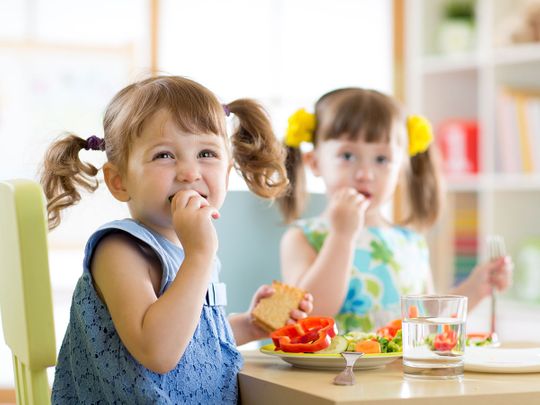
Gentle parenting, positive discipline, the idea of autonomy – all the watchwords experts tell us are important for childrearing boil down to one idea: empowerment through information and choice. But do you practise consent at meal times? And what is the fallout of not doing so? We asked the experts.
What exactly does consent mean?
It means – your body, your choice. Priyanka Dang, Clinical psychologist at Open Minds Psychiatry Counselling and Neuroscience centre, Dubai, explains: “Approximately between the age of 18 months to 3 years, children begin to express the need for independence in doing things for themselves. This is a very important stage in their psychosocial development and is known as the stage of autonomy versus shame and doubt. Food happens to be one of the first few areas in which the child learns to actively say ‘yes’ or ‘no’ and an important domain that can help children to foster a sense of independence and confidence in decision making.

When we respect a child’s take on eating or not eating something, we are showing them that their body cues (hunger cues) are valid and can be trusted.
“When we respect a child’s take on eating or not eating something, we are showing them that their body cues (hunger cues) are valid and can be trusted.”
This has a ripple down effect on other areas of their belief system.
What does empowerment look like?
Let’s start with what it doesn’t look like – chips and cake for lunch. It requires gentle allowances. “Depending on the age of the child, there are different ways in which to help them gain a sense of control or autonomy of their bodies - even when you are the one deciding meals.
“For instance, toddlers may be given the choice of what shape their fruits will be cut into. They are still eating fruit (your decision) but they can decide on the presentation (their decision). If there are certain foods that the toddler refuses to eat, alternatives may be presented which have similar nutritional values, etc.,” says Bene Katabua, Educational Psychologist at Abu Dhabi-based Intercare Health Center.
She adds: “Older children may exercise a sense of autonomy by deciding how they would like their meal prepared, for example. Some children are sensitive to certain smells or textures, and they may prefer to have the same foods prepared a different way.”

Older children may exercise a sense of autonomy by deciding how they would like their meal prepared, for example. Some children are sensitive to certain smells or textures, and they may prefer to have the same foods prepared a different way.
If you’ve got a child who feels full upon waking up or doesn’t like a big breakfast, you may tweak the mealtime, choosing to equip them with nutritious snacks a little along the way.
“Children should generally be encouraged to listen to their bodies - to recognise when they are hungry, thirsty, bored, when they are full, etc. with parents responding appropriately. This teaches them to listen to their bodies and that they can be in control of what happens to their bodies,” she explains.
Holidays, relatives and food rules
Kids thrive in an environment with boundaries, yes, but also one that has consistency. Imagine the confusion then if on holiday all expectations go unmet. What do you do when faced with a relative who has different rules than yours? “Parents can respond to this by either focusing on the child's needs, or focusing on their own needs (such as being respected as a parent in their society),” Katabua warns.
Annette Du Bois, of UK-based confidence and emotions coaching Champs Academy, suggests talking to the relatives. “Have a pre-chat with the relative before being inside the situation. If it's a food the child doesn't like, then politely decline or ask for an alternative. Also help the child understand more about not accepting something just to please other people. If they haven't tried the food, encourage exploring their taste buds and creative enjoyment,” she says.

Have a pre-chat with the relative before being inside the situation. If it's a food the child doesn't like, then politely decline or ask for an alternative. Also help the child understand more about not accepting something just to please other people.
You could also set some rules for trying out new dishes. “In some families, parents have a policy about having a bite of everything on the plate, as a way to introduce new foods to a child who is generally picky. In some instances what classifies as a ‘bite’ is also clearly defined, as well as what the child can do if they don't like the new food - such as having a small plate/napkin on the side for foods that they can't swallow after they've had a bite,” says Katabua.
However, going with the flow of someone outside the home, imposing new acts of compliance may end in blowback. “Forcing the child to eat, just in the name of compliance, can complicate their relationship with food, with their bodies, as well as their relationship with parents,” she adds.
Explaining the importance of a nutrient dense meal
Trying to educate your child about various food groups and unsure where to begin? It needs conscious consideration. “Teach through psychoeducation,” suggests Kirstan P. Lloyd, Clinical Psychologist at UAE-based Reverse Psychology. “If we don't teach our children the ‘why’, we easily fall into the trap of being a dictatorial or controlling parent. Sadly, this method of parenting begets rebellion and rarely imparts a balanced knowledge of healthy eating, healthy choices or even more profoundly, mind-body awareness.”
Ask questions about how something makes your body feel. “Most children have an idea of what their bodies feel like when they are sick or weak versus when they are healthy and feeling strong. Parents can break down basic nutrition to their child and let them know what our bodies need to feel strong and healthy. This does not have to include appearance or weight gain, but keeping the language more around what the body needs to function,” says Katabua.
And explain that sometimes, consumption must be based not on ‘how good it tastes’ but ‘how good it is for your body’.
The only way this lesson can be taught however, is through modelling healthy behaviour. Just as the only way to help a child build a good relationship with food is if you’ve got one they can see too.
Don’t do this
The negatives that we pass with a plate include:
1. Teaching kids emotional eating: “If a parent's only way of consoling a crying baby is through feeding - then that is something that may continue once the child feeds themselves - using food to regulate emotions. If parents use food to control behaviour (as punishment or reward) - that is likely to be something the child learns and they may do the same,” says Katabua.
2. Food restriction: All that’s forbidden becomes more appealing – this is human nature. When it comes to food, a parent’s control and judgement around food and eating may corrupt how the child sees meals. “The child may start to lie/hide their food intake or develop unhealthy eating patterns,” she explains.

I feel the emphasis should be on balanced nutrition that fuels our body. This means, our children are still allowed to enjoy treats, just in moderation and according to how their bodies process certain foods.
3. Fat shaming: Don’t normalise fat shaming by counting calories or making remarks about a child’s appearance – or your own for that matter. Kids’ tend to internalise their parents opinions.
4. Too much focus on healthy food: An unhealthy focus on eating healthy (orthorexia) can be as damaging, says Lloyd. “I feel the emphasis should be on balanced nutrition that fuels our body. This means, our children are still allowed to enjoy treats, just in moderation and according to how their bodies process certain foods. I feel that if we try to deprive a child of treats we may inadvertently spark an urge to binge on the forbidden food. However, if the child knows the treat is available, just so long as they have eaten their healthy meal, we can help foster healthy eating choices.”
Try this instead
1. Offer choices: The more colours on the plate, the better it is, but why not get the child to weigh in on what the rainbow will look like today?
2. Explain cause and effect: “Link the child's physical state to their food choices. For example, a child who is sensitive to preservatives may have a sore tummy after eating preservative-rich foods at a children's party. We can link their tummy ache to their over indulgence and next time they reach for a ‘trigger’ food, we can gently remind them of how they felt the last time they ate it,” says Lloyd.
3. Use visuals: Dr Majid Shahmohammadi, Psychiatrist at UAE-based Open Minds Centre, calls for the use of infographics, photos and videos to educate kids in an age-appropriate manner.
When can the educating begin?
Lloyd believes at birth. “I am a big believer in child-centred parenting practices. With a newborn, this can mean on demand feeding where we allow our new born to let us know when they are hungry and when they are full.
“We can also talk to our children throughout their lives about food and their bodies and how they feel. This could mean gently cooing to a baby that they are full and need to be burped, or tracking our toddler as they reach for a snack, or having a more mature conversation with our five year old over what protein they would prefer for dinner.”
UAE-based expat Rabia Sarfaraz has a two and a half year old. She explains that baby-led weaning (BLW); i.e. allowing a child to self-feed; helped her fussy eater revise their relationship with food. “We started our child with purees and spoon feeding,” she says, “Not baby-lead weaning.”
She says it didn’t work for her family. “Our child disliked it very much and we began to worry that mealtime would soon become stressful for all of us as a family. Within 10 days we had stopped solid foods and then took a break of one or two weeks. We then began afresh with BLW exclusively.

For about five months we let our child play, explore, taste, smell and interact with the variety of foods on offer.
“For about five months we let our child play, explore, taste, smell and interact with the variety of foods on offer. To be fair, it was tiresome as it is very messy, and requires a lot of focus and attention. Often I wondered if we made the right choice because friends and family would ask why our child wasn’t eating anything and whether this was affecting their nutritional intake. But we decided to stick to our decision.”
A year on, the baby began to eat. “It was like magic! Picking up a spoon full of food, putting bites into their mouth,” she says. “I can now fast-forward to two and a half years of age and they are still a ‘great eater’, not too suspicious of new tastes/textures and enjoying the independence of self-feeding.”
And it’s easy on the parents, says Sarfaraz. The key is to involve the child in meal plans, to ask and pay heed to their opinions. Empowerment is the way to success.
Write to us at parenting@gulfnews.com



